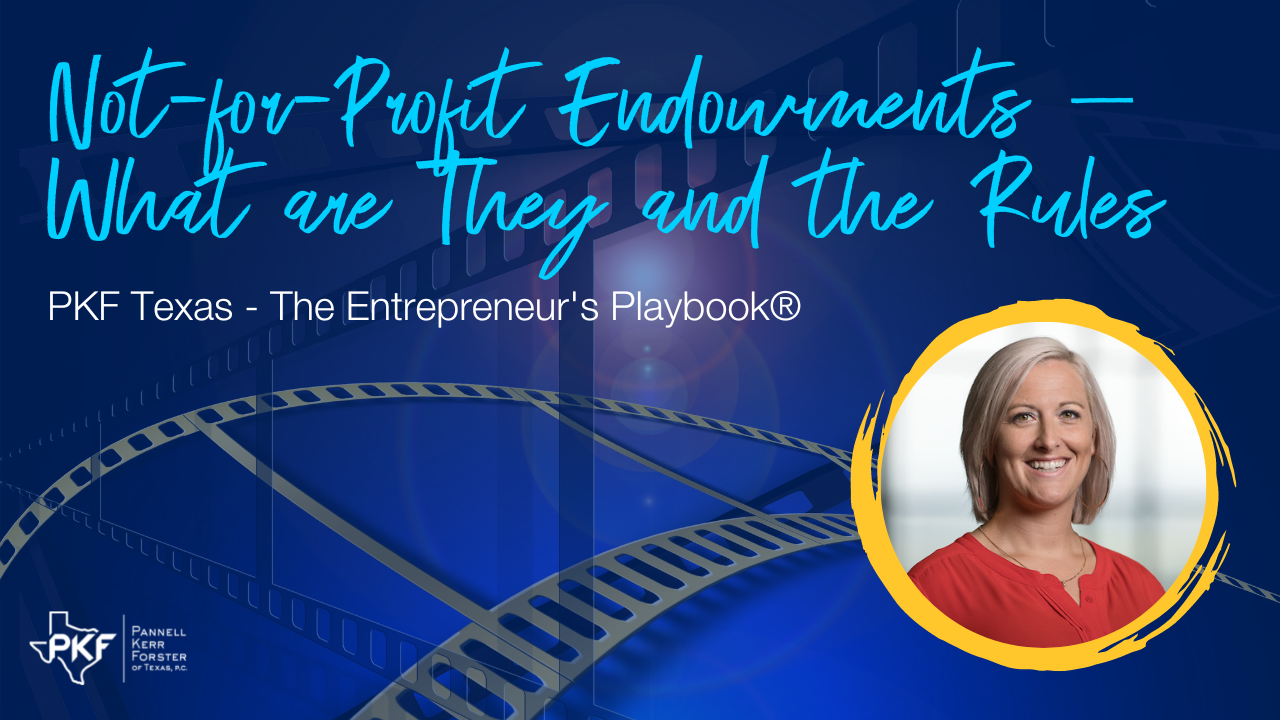Not-for-Profit Endowments – What are They and the Rules

If your not-for-profit receives an endowment, what are the next steps? Make sure your organization understands how to utilize the donation funds. In this next episode of PKF Texas – The Entrepreneur’s Playbook®, Audit Director Nicole Riley, CPA, CFE, explains important things to know.
Table of contents
Jen: This is the PKF Texas – Entrepreneur’s Playbook®. I’m Jen Lemanski and I’m back once again with Nicole Riley, an Audit Director and one of the Approachable AdvisorsTM on our not-for-profit team. Nicole, welcome back to the Playbook.
Nicole: Hi. Thanks for having me.
What is an Endowment?
Jen: So, in the not-for-profit world, and we see it on PBS, “This is an endowment of…” This may sound like a silly question, but what’s an endowment?
Nicole: So, an endowment is essentially a gift from a donor that the organization is supposed to hold in perpetuity, aka forever. It’s a forever donation. And the purpose of them is so that the organization has a bulk amount of money that provides investment earnings back every year to be provided for operations.
Jen: Does that differ from like an operating reserve? I’ve heard that term used before.
Nicole: It really does. So, there’s a corpus, we call it a corpus, but the initial gift in an endowment is held forever. And it’s the investment earnings that get allocated out every year to be used for either a specific purpose that the donor wanted, like scholarships or any kind of programmatic thing that the organization is doing, versus an operating reserve is a fund that’s really there for a rainy day. And usually with the board approval, you could use the whole thing of an operating reserve. It’s really bad weather.
Jen: You’ve run into trouble or you run into unexpected expenses. Something like that.
Nicole: Yeah. Repairs and maintenance on a building – those big expenses that you have to save up for that you know will happen and you’re going to need to spend it.
The Rules
Jen: You just don’t know when. So, are there rules then that govern an endowment and how it can be used?
Nicole: Absolutely. So, because we’re talking about a lot of funds, I mean, if you think about the colleges that have large endowments, there’s a lot of money that donors have given to endowments. So, there is an actual act, and it’s called UPMIFA but essentially, it’s rules on what is prudent, what’s a prudent investor and what’s reasonable fiscal responsibility around those large amounts of money.
Jen: So, when an organization accepts an endowment, should there be policies around that endowment? Internal policies?
Three Policies to Put in Place
Nicole: There absolutely should. So, UPMIFA is, at the state level, it’s actual laws in place around endowments, but the organization should really… there’s three main things that they definitely need to have in place.
They need to have a spending policy, which decides how much of the endowment can be spent. UPMIFA has strict rules that in no case can it be more than seven, but it’s usually no more than 5% of the gift and of the investment that can be used each year. So, the organization needs to—and a lot of organizations will be between 4% and 5% each year.
And then they also need to have an investment policy. So, obviously a big amount of money, how is it going to be invested in, what are the, you know, how much risk is the organization willing to take as it invests, you know, bonds versus stocks, domestic versus international. Those are board decisions that need to be made.
And then third and final, the other big decision is right now we’re kind of in a weird time again where the stock market hasn’t been doing great, it’s come down quite a bit. So, there is a potential where your investment could fall below the original gift, and that’s what we call an underwater endowment. What’s your policy if that happens? Some organizations completely stop spending if that happens. Others allow for it to a certain extent.
So, those are just really important decisions that the board needs to make at the time the endowments made and the time the endowments are set up, so that once those things happen, you can stay within policy and the decisions are already made.
Jen: That makes a lot of sense. Well, we’ll get you back to talk a little bit more about some other not-for-profit topics. Sound good?
Nicole: That sounds great.
Jen: This has been another thought leadership production brought to you by PKF Texas – The Entrepreneur’s Playbook®. For more information about this and other topics, visit PKFTexas.com/Insights. Tune in next week for another chapter.

